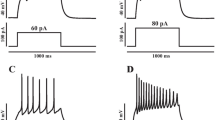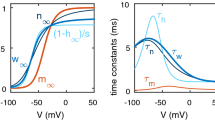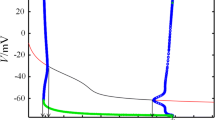Abstract
Neuronal oscillatory activity is generated by a combination of ionic currents, including at least one inward regenerative current that brings the cell towards depolarized voltages and one outward current that repolarizes the cell. Such currents have traditionally been assumed to require voltage-dependence. Here we test the hypothesis that the voltage dependence of the regenerative inward current is not necessary for generating oscillations. Instead, a current I NL that is linear in the biological voltage range and has negative conductance is sufficient to produce regenerative activity. The current I NL can be considered a linear approximation to the negative-conductance region of the current–voltage relationship of a regenerative inward current. Using a simple conductance-based model, we show that I NL , in conjunction with a voltage-gated, non-inactivating outward current, can generate oscillatory activity. We use phase-plane and bifurcation analyses to uncover a rich variety of behaviors as the conductance of I NL is varied, and show that oscillations emerge as a result of destabilization of the resting state of the model neuron. The model shows the need for well-defined relationships between the inward and outward current conductances, as well as their reversal potentials, in order to produce stable oscillatory activity. Our analysis predicts that a hyperpolarization-activated inward current can play a role in stabilizing oscillatory activity by preventing swings to very negative voltages, which is consistent with what is recorded in biological neurons in general. We confirm this prediction of the model experimentally in neurons from the crab stomatogastric ganglion.








Similar content being viewed by others
References
Ball, J. M., Franklin, C. C., Tobin, A. E., Schulz, D. J., & Nair, S. S. (2010). Coregulation of ion channel conductances preserves output in a computational model of a crustacean cardiac motor neuron. Journal of Neuroscience, 30(25), 8637–8649.
Bazhenov, M., Timofeev, I., Steriade, M., & Sejnowski, T. J. (2002). Model of thalamocortical slow-wave sleep oscillations and transitions to activated States. Journal of Neuroscience, 22(19), 8691–8704.
Blethyn, K. L., Hughes, S. W., Toth, T. I., Cope, D. W., & Crunelli, V. (2006). Neuronal basis of the slow (<1 Hz) oscillation in neurons of the nucleus reticularis thalami in vitro. Journal of Neuroscience, 26(9), 2474–2486.
Brickley, S. G., Aller, M. I., Sandu, C., Veale, E. L., Alder, F. G., Sambi, H., et al. (2007). TASK-3 two-pore domain potassium channels enable sustained high-frequency firing in cerebellar granule neurons. Journal of Neuroscience, 27(35), 9329–9340.
Cantrell, A. R., & Catterall, W. A. (2001). Neuromodulation of Na + channels: an unexpected form of cellular plasticity. Nature Reviews Neuroscience, 2(6), 397–407.
Cymbalyuk, G. S., Gaudry, Q., Masino, M. A., & Calabrese, R. L. (2002). Bursting in leech heart interneurons: cell-autonomous and network-based mechanisms. Journal of Neuroscience, 22(24), 10580–10592.
Del Negro, C. A., Koshiya, N., Butera, R. J., Jr., & Smith, J. C. (2002). Persistent sodium current, membrane properties and bursting behavior of pre-botzinger complex inspiratory neurons in vitro. Journal of Neurophysiology, 88(5), 2242–2250.
Desai, N. S., Rutherford, L. C., & Turrigiano, G. G. (1999). Plasticity in the intrinsic excitability of cortical pyramidal neurons. Nature Neuroscience, 2(6), 515–520.
DiFrancesco, D. (2005). Cardiac pacemaker I(f) current and its inhibition by heart rate-reducing agents. Current Medical Research and Opinion, 21(7), 1115–1122.
Dunmyre, J. R., Del Negro, C. A., & Rubin, J. E. (2011). Interactions of persistent sodium and calcium-activated nonspecific cationic currents yield dynamically distinct bursting regimes in a model of respiratory neurons. Journal of Computational Neuroscience, 31(2), 305–328.
Goldman, M. S., Golowasch, J., Marder, E., & Abbott, L. F. (2001). Global structure, robustness, and modulation of neuronal models. Journal of Neuroscience, 21(14), 5229–5238.
Golowasch, J., & Marder, E. (1992a). Ionic currents of the lateral pyloric neuron of the stomatogastric ganglion of the crab. Journal of Neurophysiology, 67(2), 318–331.
Golowasch, J., & Marder, E. (1992b). Proctolin activates an inward current whose voltage dependence is modified by extracellular Ca2+. Journal of Neuroscience, 12(3), 810–817.
Haedo, R. J., & Golowasch, J. (2006). Ionic mechanism underlying recovery of rhythmic activity in adult isolated neurons. Journal of Neurophysiology, 96(4), 1860–1876.
Hodgkin, A. L., Huxley, A. F., & Katz, B. (1952). Measurement of current–voltage relations in the membrane of the giant axon of Loligo. The Journal of Physiology, 116(4), 424–448.
Hooper, S. L., & Marder, E. (1987). Modulation of the lobster pyloric rhythm by the peptide proctolin. Journal of Neuroscience, 7(7), 2097–2112.
Jahnsen, H., & Llinas, R. (1984). Ionic basis for the electro-responsiveness and oscillatory properties of guinea-pig thalamic neurones in vitro. The Journal of Physiology, 349, 227–247.
Khorkova, O., & Golowasch, J. (2007). Neuromodulators, not activity, control coordinated expression of ionic currents. Journal of Neuroscience, 27(32), 8709–8718.
Koizumi, H., & Smith, J. C. (2008). Persistent Na+ and K+ −dominated leak currents contribute to respiratory rhythm generation in the pre-Botzinger complex in vitro. Journal of Neuroscience, 28(7), 1773–1785.
Kramer, R. H., & Zucker, R. S. (1985). Calcium-dependent inward current in Aplysia bursting pace-maker neurones. The Journal of Physiology, 362, 107–130.
Kuznetsov, I. U. A. (2004). Elements of applied bifurcation theory (3rd ed., Applied mathematical sciences, Vol. 112). New York: Springer.
Li, J., & Baccei, M. L. (2011). Pacemaker neurons within newborn spinal pain circuits. Journal of Neuroscience, 31(24), 9010–9022.
Lu, T. Z., & Feng, Z. P. (2012). NALCN: a regulator of pacemaker activity. Molecular Neurobiology, 45(3), 415–423.
McCormick, D. A., & Bal, T. (1997). Sleep and arousal: thalamocortical mechanisms. Annual Review of Neuroscience, 20, 185–215.
McCormick, D. A., & Huguenard, J. R. (1992). A model of the electrophysiological properties of thalamocortical relay neurons. Journal of Neurophysiology, 68(4), 1384–1400.
Pang, D. S., Robledo, C. J., Carr, D. R., Gent, T. C., Vyssotski, A. L., Caley, A., et al. (2009). An unexpected role for TASK-3 potassium channels in network oscillations with implications for sleep mechanisms and anesthetic action. Proceedings of the National Academy of Sciences of the United States of America, 106(41), 17546–17551.
Prinz, A. A., Bucher, D., & Marder, E. (2004). Similar network activity from disparate circuit parameters. Nature Neuroscience, 7(12), 1345–1352.
Rekling, J. C., Funk, G. D., Bayliss, D. A., Dong, X. W., & Feldman, J. L. (2000). Synaptic control of motoneuronal excitability. Physiological Reviews, 80(2), 767–852.
Robinson, R. B., & Siegelbaum, S. A. (2003). Hyperpolarization-activaterd cation currents: from molecules to physiological function. Annual Review of Physiology, 65, 453–480.
Selverston, A. I., Russell, D. F., & Miller, J. P. (1976). The stomatogastric nervous system: structure and function of a small neural network. Progress in Neurobiology, 7(3), 215–290.
Sharp, A. A., O’Neil, M. B., Abbott, L. F., & Marder, E. (1993). Dynamic clamp: computer-generated conductances in real neurons. Journal of Neurophysiology, 69(3), 992–995.
Swensen, A. M., & Bean, B. P. (2005). Robustness of burst firing in dissociated purkinje neurons with acute or long-term reductions in sodium conductance. Journal of Neuroscience, 25(14), 3509–3520.
Swensen, A. M., & Marder, E. (2000). Multiple peptides converge to activate the same voltage-dependent current in a central pattern-generating circuit. Journal of Neuroscience, 20(18), 6752–6759.
Tobin, A. E., Van Hooser, S. D., & Calabrese, R. L. (2006). Creation and reduction of a morphologically detailed model of a leech heart interneuron. Journal of Neurophysiology, 96(4), 2107–2120.
Tryba, A. K., Pena, F., & Ramirez, J. M. (2006). Gasping activity in vitro: a rhythm dependent on 5-HT2A receptors. Journal of Neuroscience, 26(10), 2623–2634.
Turrigiano, G., Abbott, L. F., & Marder, E. (1994). Activity-dependent changes in the intrinsic properties of cultured neurons. Science, 264(5161), 974–977.
Zhao, S., Golowasch, J., & Nadim, F. (2010). Pacemaker neuron and network oscillations depend on a neuromodulator-regulated linear current. Frontiers in Behavioral Neuroscience, 4, 21.
Acknowledgments
This work was supported by NSF DMS1122291 (AB), NIH MH064711 (JG) and NIH MH060605 (FN).
Conflict of interest
The authors declare that they have no conflict of interest.
Author information
Authors and Affiliations
Corresponding author
Additional information
Action Editor: Mark Goldman
Appendix
Appendix
We used the following set of equations for simulations associated with Figs. 4, 5, 6, 7, and 8.
where
The gating functions are
and the time constants are given by τ K (v) = τ 1/[1 + exp(v/k s )] and τ h (v) = τ h1 ms. The following parameter values were used in all simulations E K = − 80 mV, g K = 0.5, I ext = 0, and C m = 1.0 nF
In Figs. 4 and 5 there was no h current, which we modeled simply by setting g h = 0 μS. We let E NL = − 79 mV, w mid = − 60 mV, k s = 2 mV. For Fig. 4, we used k 1 = 2 mV and τ 1 = 60 ms. For Fig. 5a, we used k 1 = 4 mV and τ 1 = 80 ms. For Fig. 5b, we used k 1 = 4 mV and τ 1 = 60 ms.
In Fig. 6, an instantaneous version of the h current was used, i.e., the equation for h ′ was replaced with h ≡ h ∞ (v). For this figure, parameter values from Fig. 5a were used. In addition, E h = − 30 mV, h mid = − 85 mV, h 1 = 2 mV, E NL = −75 mV and g NL = − 0.15 μS. Figure 6b was obtained by varying h mid while g h = 1 μS was fixed.
In Fig. 7, we used parameter values from Fig. 5a with g NL = − 0.45 μS, E NL = −75 mV, g h = 1. The perturbation was achieved be setting I ext = −1 for 50 mS.
In Fig. 8, we used C m = 10.0 nF, τ h1 = 200 ms, τ 1 = 600 ms to match the biological timescale. Additionally, we set τ K (v) = τ 1/cosh((v − w mid ))/k s ) with k s = 5.6 mV, g NL = − 0.45 μS, E NL = − 65 mV, w mid = − 40 mV, g h = 0.8 μS and h 1 = 6 mV.
Rights and permissions
About this article
Cite this article
Bose, A., Golowasch, J., Guan, Y. et al. The role of linear and voltage-dependent ionic currents in the generation of slow wave oscillations. J Comput Neurosci 37, 229–242 (2014). https://doi.org/10.1007/s10827-014-0498-4
Received:
Revised:
Accepted:
Published:
Issue Date:
DOI: https://doi.org/10.1007/s10827-014-0498-4




